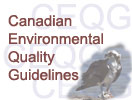

 
|
|
|
|
|
||

Home About Us What's New?/ What Are We Working On? Canadian Environmental Quality Guidelines Download Documents Bibliography CCME Links Contact Us Site Map |
Canadian Tissue Residue Guidelines (CTRGs)OverviewA number of wildlife species, such as bald eagles, osprey, many colonial nesting birds, and semi-aquatic mammals (such as mink, otter, and polar bear), are dependent on aquatic species, such as fish, shellfish, and aquatic plants, as their primary source of food. These aquatic prey species on which wildlife depend for food can accumulate into the tissues of their bodies toxic substances such as certain metals, organometals, and highly hydrophobic organic substances from water, suspended solids, sediment, and food. These substances accumulate/concentrate in aquatic biota due to the high rates at which they are taken up, but slow rates at which they are metabolized and excreted. As a result, these aquatic organisms can have concentrations of toxic substances in their tissues which are orders of magnitude higher than in their surrounding environment. In turn, the consumption of such contaminated aquatic food is the main route of exposure for these wildlife species to these so-called persistent, bioaccumulative, toxic substances. Canadian Tissue Residue Guidelines for the Protection of Wildlife Consumers of Aquatic Biota (CTRGs) are intended to protect wildlife species that depend on aquatic organisms for food. The CTRGs are therefore, based on the highest concentration of a chemical in the body tissues of their aquatic food organisms that is not expected to result in adverse effects to them. CTRGs are appropriate tools to protect wildlife in aquatic ecosystems for two main reasons. First, aquatic food consumption is the main exposure route to persistent, bioaccumulative, toxic substances. Second, water quality guidelines are not deemed appropriate for these substances since they are more likely to partition into the tissues of aquatic organisms or sediments rather than stay in the water column. Development of Canadian Tissue Residue Guidelines began in the mid-1990s. Procedures for Guideline Development (Protocol)Tissue Residue Guidelines are designed mainly for persistent, bioaccumulative, toxic substances that are targeted for virtual elimination from the environment under various provincial, national, and international policies (e.g., Government of Canada/Environment Canada 1995; OMOEE 1993; International Joint Commission 1987). Tissue Residue Guidelines and other environmental quality guidelines provide benchmarks to help interpret biological monitoring data and serve as the scientific basis for determining interim management objectives and performance indicators to measure progress in virtual elimination strategies. Tissue Residue Guidelines are developed according to a Protocol for the Derivation of Canadian Tissue Residue Guidelines for the Protection of Wildlife that Consume Aquatic Biota (CCME 1998). Application of GuidelinesTissue Residue Guidelines play an integral role in environmental quality management and should be considered in conjunction with other supporting data including environmental quality guidelines for other media. The Guidelines should not be regarded as blanket values for national protection of wildlife consumers of aquatic biota. Variations in environmental conditions and resident aquatic food organisms and wildlife species across Canada may require guidelines to be modified accordingly. The proper use and site-specific modification of the Canadian Tissue Residue Guidelines for the protection of local wildlife species (e.g., those species that the CTRG are not based on) requires an understanding of the various avian and mammalian reference concentration values (i.e., the contaminant level in prey items considered to be protective of a specific species). For more information on the use of reference concentrations, please see the protocol. Products AvailableProtocolThe Protocol of the Canadian Tissue Residue Guidelines is available in HTML and PDF format. You need Adobe® Acrobat® Reader to view and print the PDF file. If you do not already have Acrobat® Reader, you may download it at no charge. |
|
The Green LaneTM, Environment Canada's World Wide Web site
|
||
|
Last updated: 2004-03-01
Last reviewed: 2004-03-01 |
||
|
|
||